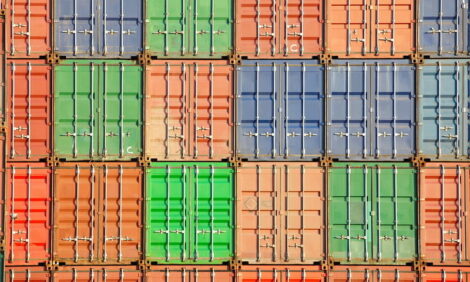



Potential for Part-Dried Ethanol By-product as Feed
US - A cheaper ethanol by-product - part-dried distillers grains - and soybean meal could help pork producers cut feed costs, according to recent research from Southern Illinois University Carbondale. The partial drying reduces the cost and greenhouse gas emissions for the full drying required to produce distillers dried grains with solubles (DDGS). This product, extruded with soybean meal, was found to be a good feed for pigs.Gary A. Apgar, an animal scientist at Southern Illinois University Carbondale, has been testing a blend of distillers grains — the fat, minerals, vitamins and fibre remaining after corn's starch becomes fuel — and soybeans, a traditional protein source for swine. According to a report in Southern Illinoisan, the combination turns out to be every bit as nutritious as soybean meal and, because grains cost less than beans, it is cheaper, too.
"Soy meal runs about $300 per ton and contains about 47.5 per cent crude protein, where distillers grains cost about $125 per ton and contain 27 per cent crude protein," Dr Apgar said.
"If for $250 you can get 54 per cent crude protein, it's much more economical."
Dr Apgar's work is part of a larger project aimed at solving two problems facing the ethanol industry: factory emissions in newer plants that exceed US Environmental Protection Agency limits and the need to deal with the increased volume of byproducts that will result from expanded ethanol production. Dr Apgar's group – a consortium of private company representatives, university researchers and scientists from a national laboratory based in Peoria – is tinkering with the production process at a new ethanol plant in Wisconsin, hoping to cut emissions while turning the left-over grains into a more marketable livestock feed.
Newer plants generally use a dry mill process to produce ethanol, but the drying creates greenhouse gasses (GHG). Wet milling solves the emissions problem, but the grains left behind spoil more easily than dried distillers' grains and are harder to ship, thus reducing their value.
So the researchers began looking at trade-offs. They hypothesised that by shutting off the drying process early for about 15 per cent of the residue, they could reduce emissions enough to meet EPA standards. By adding soybeans to the semi-wet grains, compressing the two and forcing them through an extruder (a process which helps prevent spoilage), they hoped to create a feed with the higher nutritional value of wet grains plus the shelf life and handling ease of the dried variety.
But would this new feed provide an adequate mix of nutrients for pigs? And would the extrusion process itself have any effect on the feed's nutrients?
"Extrusion involves both pressure and heat," Dr Apgar said. "This reaction can cause carbohydrates and proteins to bind to each other. When they don't break down, they're not available to the animal."
To test the feed digestibility, Dr Apgar analyzed faeces and urine produced by pigs fed wet grains, pigs fed dried grains, pigs fed the extruded grains/soybean mix and those fed a grains/soy mix that had not gone through the extruder. He also wanted to know how much of the feed's nitrogen wound up outside the pigs.
"Poor nitrogen digestion would say we had affected the metabolic process negatively," Dr Apgar explained. "The pig couldn't use it, so he was just excreting it.”
To get the data, Dr Apgar used a system that allows collection of virtually all of the material passing through the last section of a pig's small intestine.
"Most systems only collect 40 per cent of the sample that goes by — it's incomplete," he said.
Dr Apgar found the mix performed better than he thought it would, proving significantly more digestible, in terms of the essential amino acids a pig needs, than the grains by themselves. While roughly two-thirds of that effect came from the soybean meal, the fact that wet grains cost around $50 per ton as compared to $125 for dry grains means the mixed feed would cost less than rations consisting solely of either dried grains or soybeans.
When it came to nitrogen, Dr Apgar found that although extruded feed containing distillers' grains did lessen the amount of nitrogen the pig used, the excess tended to wind up in the feces rather than the urine.
"That's not a bad thing because the effluent can be used in crop production (as fertilizer), where a high nitrogen content better matches corn production needs," Dr Apgar said.
Dr Apgar and a graduate student reported these results last summer during a national meeting of the American Society of Animal Science in Indianapolis.
"After the presentation, we had a line of extension agents and other researchers wanting to talk with us about the impact," Dr Apgar told Southern Illiniosan.
"This could give farmers a protein source that would allow them to maximize the inclusion rate of a low-cost ingredient when formulating their rations. On the industry side, it could reduce the environmental impact of ethanol production while enhancing the value of by-product production."








